First, some real estate lessons from Portland. When the under-developed Willamette River waterfront, on the southeast edge of downtown, was starting to undergo gentrification, one of the first occupants was local stalwart McCormick & Schmick's. A well-funded corporate restaurant, the thinking was, could tough it out until the neighborhood filled. The assumption was right on the money; the restaurant hung on for a good 10 years, and now it'ês doing just fine.
The waterfront, now known as RiverPlace, and the adjacent South Waterfront are at last dotted with housing clusters and related retail (dry-cleaners, for example), new medical buildings and parking garages. But McCormick & Schmick'ês is the only game of its kind in town; except for a couple of wine bars and coffee shops, there's still not much in the way of new local restaurants. And that's despite easy access from downtown on Portland's spiffy streetcar.
Portland built another neighborhood as well, the Pearl District. This was classic urban infill: brick warehouses transformed into offices, print shops into bakeries and bars, sleek new condos, industrial-chic restaurants. No corporate, 800-pound gorilla as anchor, yet the entire district has become a destination, day and night.
In Seattle, Vulcan Real Estate's South Lake Union development combines the Pearl and RiverPlace models. Our fancy new South Lake Union Streetcar, affectionately nicknamed SLUT (just substitute "trolley" for "streetcar"), leads you from the downtown core into the heart of a rich urban infill. High-tech centers and scientific research buildings abound, built to include all the piping and wiring necessary in a digital age. There are also restaurants aplenty, many in place for years to take advantage of the lakefront views.
South Lake Union, with easy access from the Eastside via Highway 520, has the potential to attract suburbanites looking for a night 'êdowntown.'ê The lake itself is ringed by safe, mid-level corporate restaurants (Daniel's Broiler, Chandler's Crabhouse) with plenty of parking; there's even a Hooters for carousing account execs and visiting salesmen. (So far, SLU hasn't developed into the new Bellevue; old Bellevue — with at least a dozen new high-end bars, restaurants, and plenty of valet parking — has become the new Bellevue.)
Amazon employees, UW medical researchers and bio-tech lab workers can fill the neighborhood by day, but who's going to keep SLU hopping after dark? It'ês not enough to count on the captive audience of high-rise condo dwellers, even though 'êdozens of eclectic restaurants at your doorstep'ê is a staple of sales brochures, Vulcan's included. Nor should it be assumed all those engineers and researchers will celebrate their latest discoveries with Dom Perignon and foie gras.
Instead, if you're the developer, you have to win over locals who are staying away for whatever reasons — maybe the neighborhood riff-raff. This strategy works best with restaurants that have familiar local names, not national chains (like Maggiano's Little Italy) or even local chains (like Restaurants Unlimited/Palomino or Consolidated Restaurants/Elliott's Oyster House) that are site-specific. What you do instead, if you're trying to build the 'ênabe,'ê is reel in celebrity chefs like William Belickis, who just re-opened Mistral Kitchen in a vast space at Eighth Avenue and Westlake Avenue (technically just outside the boundaries of the area Vulcan is developing), or lasso existing restaurants with a strong local following and a lease that's about to expire.
That's why this week's news that Chris Keff is moving her Flying Fish to the 320 Westlake Building this spring makes such good sense. After 15 years in Belltown, she told Seattle Weekly, she was tired of the neighborhood's club-goers and drug dealers. There's a good reason for Vulcan to import an existing restaurant: Its local reputation is already established and its popularity isn't based on location alone, as with Ray's, Salty's, and the Space Needle restaurant. Keff told The Seattle Times as much: 'ê[Vulcan] has a very specific vision for South Lake Union ... four or five restaurants of my caliber: very local, very Seattle restaurants.'ê
John Howie of Seastar was the first such high-profile restaurateur to open in South Lake Union; he's also keeping the original Seastar in Bellevue and has just opened John Howie Steak in Bellevue's new Bravern complex. But he won't be the last. One celebrity chef who's already made the move is Jason Wilson, who normally runs a charming 'êhouse restaurant,'ê Crush, on East Madison Street. Wilson gussied up an anonymous-looking building at the dead-end of Pontius Avenue North and Mercer Street, and is using it as a stand-alone, private-dining venue.
Who might be next? The obvious possibility is Tom Douglas, who already has half a dozen outlets downtown, all along the axis of Virginia Street. The Vulcan properties are only three blocks away. A new Palace Kitchen isn't that far-fetched.
And who else? The speculation game is already underway. Wild Ginger? Le Pichet/Cafe Presse? Zoe/Quinn's? A vegetarian powerhouse like Cafe Flora? A new venture from Mike McConnell of Via Tribunali (that wouldn'êt compete with Tutta Bella)? A new offering from Ethan Stowell? Another El Gaucho?
Vulcan is no doubt dangling the carrot of favorable lease terms in front of more than one restaurateur, though no one's naming names and Vulcan officials declined to comment. (All concerned know it's bad manners to talk with your mouth full.) South Lake Union is already home to some four dozen eating establishments, from hot dogs (Slo Joe'ês) to haute cuisine (the Jewel Box dining room at Mistral Kitchen), but there's always room for one more.


